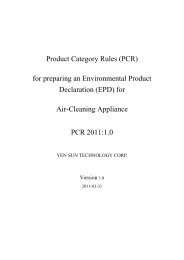Product Category Rules (PCR) - PCR Library
Product Category Rules (PCR) - PCR Library
Product Category Rules (PCR) - PCR Library
You also want an ePaper? Increase the reach of your titles
YUMPU automatically turns print PDFs into web optimized ePapers that Google loves.
construction of plastic containers and packaging;<br />
- Stopper, lid, cap and the like; divider and the like; label, sticker and the like;<br />
and handle, string and the like that are attached to plastic containers and<br />
packaging for the purpose of making them more functional;<br />
- Packing materials used to transport plastic containers and packaging to the<br />
production stage; and<br />
- Plastic containers and packaging for “attachments” and “giveaways”.<br />
3 Referenced Standards<br />
Following items are excluded from the components of this <strong>PCR</strong>:<br />
- Attachments itself (such as a spoon attached to a cup of yogurt); and<br />
- Giveaways itself (such as a small toy enclosed in a box of candy)<br />
Any of the following standards and TS referred to in this <strong>PCR</strong> shall constitute a<br />
and <strong>PCR</strong>s<br />
part hereof:<br />
- JIS Z 0108: 2005 Glossary of Terms for Packaging;<br />
- JIS K 6900: 1994 Plastics - Vocabulary;<br />
- JIS B 8650: 2006 Plastics Molding Machinery - Vocabulary;<br />
- JIS Z 0112: 2008 Packaging - Environmental terminology;<br />
- JIS Z 8123: 1995 Graphic Arts - Glossary - Fundamental Terms; and<br />
- TS Q0010: 2009 General Principles for the Assessment and Labeling of<br />
Carbon Footprint of <strong>Product</strong>s<br />
4 Terms and Definitions See terms listed below and in “Annex C (normative): Terms and Definitions” for<br />
terms and definitions of this <strong>PCR</strong>.<br />
(1) Plastics (refer to JIS K 6900: 1994)<br />
Materials containing high polymers as essential components that are capable<br />
of being shaped or formed as required at any manufacturing phase of finished<br />
products.<br />
(2) Individual packaging (refer to JIS Z 0108: 2005)<br />
A technique to package individual items of goods using appropriate materials,<br />
containers, etc. in order to enhance their commercial values or to protect each<br />
of them; or the condition where such technique has been performed. It also<br />
serves as a medium of communicating information such as product labeling.<br />
(3) Inner packaging (refer to JIS Z 0108: 2005)<br />
A technique to package goods inside the packaged freight using appropriate<br />
materials, containers, etc. in order to protect them from the adverse effects<br />
caused by water, humidity, light, heat, shocks, etc.; or the condition where such<br />
technique has been performed.<br />
(4) Outer packaging (refer to JIS Z 0108: 2005)<br />
A technique to put bulk or packaged goods into containers such as boxes,<br />
bags, barrels and cans or to bundle them together without using such<br />
containers, and thereafter, to print symbols, shipping marks and other<br />
descriptions on such containers or goods bound together as necessary; or the<br />
condition where such printing has been performed. It is also called “packing”.<br />
(5) Cling films for food wrapping<br />
Plastic films having such characteristics as transparency, resistance to<br />
moisture, self-adhesiveness that is used for food wrapping for storage, cooking<br />
and other purposes.<br />
(6) Garbage bags<br />
Rectangular or U-shaped plastic bags generally made of polyethylene that is<br />
designed exclusively for collecting non-industrial waste.<br />
(7) Attachments<br />
Articles which are attached to the goods when they are sold, and do not<br />
constitute any part of such goods or the containers or packaging thereof, such<br />
as a spoon attached to a cup of yogurt.<br />
-3-















